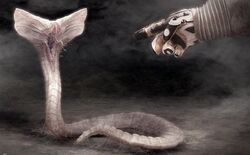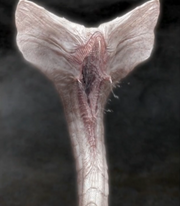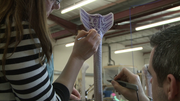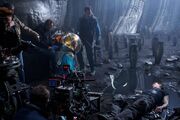The Hammerpede is an extraterrestrial creature resulting from indigenous worms of LV-223 being exposed to Chemical A0-3959X.91 – 15. Whether they can be formed from other species of worm on other planets is unknown.
Origins[]
When the USCSS Prometheus arrived on LV-223, the crew, led by Dr. Elizabeth Shaw and Charlie Holloway, discovered a temple, which they explored. When they disturbed a room containing ampules of Chemical A0-3959X.91 - 15, the chemical began to leak out of the urns onto the floor, infecting several worms which mutated into Hammerpedes.

Concept art of the Hammerpede.
Millburn and Fifield, two members of the crew, got lost and managed to reach the same urn room, where they discovered two Hammerpedes. One of them rose and scared Fifield but Millburn looked upon it, fascinated. Millburn unwisely tries to touch the creature despite it obviously showing warning posture, and it flared its 'crests' and attacked him, constricting Millburn's arm. Fifield tried to help Millburn, but his touching it only made the Hammerpede constrict tighter, which resulted in it breaking Millburn's arm. In a further attempt to save Millburn, Fifield cut off the Hammerpede's head, causing its acidic blood to spray on Fifield's helmet faceplate, which melted it. The Hammerpede then regrew its head, showing its regenerative abilities and slipped into Millburn's suit through a hole made by his protruding bone, entering his mouth and subduing him.
Meanwhile, Fifield fell into the A0-3959X.91 - 15 on the floor, which would later begin to transform him into a grotesque mutant. When the rest of the crew went to save the two members the next day, they discovered Millburn's body, and a Hammerpede jumped out of his mouth and back into the A0-3959X.91 - 15.
Characteristics[]
The Hammerpede has pale, white-grey skin with a somewhat translucent appearance, attributes that resemble those of a Neomorph. Like the indigenous worms they mutated from, Hammerpedes have serpent-like bodies but can grow up to 4 feet long. Their 'crests' are reminiscent of the hoods possessed by cobras. These 'crests' can be folded in and out around the creature's mouth. They possess incredible strength, able to break bones rather easily, which was demonstrated when Fifield attempted to remove one from Millburn's forearm. They also possess acidic blood and the ability to rapidly regenerate severed parts in a matter of seconds, which was seen when Fifield attempted to decapitate one, only to have its head quickly regenerate.
Behind the Scenes[]
Design[]

Concept art by Martin Rezard.[1]
In Jon Spaihts' original script for Prometheus, titled Alien: Engineers, the Hammerpede is described as a centipede-like creature, although it maintains the flat head design of the final version seen in the film.[2] Originally conceived by Carlos Huante, the Hammerpede was to be a precursor to the Facehugger, with a centipede-esque configuration, complete with numerous gripping fingers or limbs. This derived in the creature's name, given by the production crew, after the peculiar hammer-esque shape of its head and the initial influence from chilopoda. As the designing process progressed, the Hammerpede's appearance progressively abandoned multiple arthropod-esque limbs — in favor of a smoother, limbless and more worm-like configuration. In the final film, quite in fact, the creature is a simple worm — mutated beyond recognition by the mysterious black liquid released by the ampules. The final design was digitally realized by Martin Rezard. The Hammerpede, as it is seen in the film, was inspired by translucent abyssal animals, with evident "arteries and veins and organs sitting below the surface of the skin," as noted by special effects supervisor Neal Scanlan in Prometheus: The Art of the Film.[1]
Practical and CGI models[]

One of the Hammerpede's inner 'layers', in the process of painting.[1]
As per the other character and creature specific effects, the creature was built practically by his Studio — with a digital counterpart provided by MPC. The creature was sculpted by Waldo Mason and Martin Rezard; the Hammerpede actually included several 'layers', ranging from the external skin to the internal organs and muscles. Each 'layer' was sculpted and molded separatedly and then assembled onto the final model, which included mechanical features by Jim Sandys and Steve Wright. The Hammerpede’s skin was molded in translucent silicone.[1]
Scanlan commented: "ultimately the detail is from this beautiful sort of skeletal structure, with muscle that sits beneath, which we painted with lots of pearlescent paints and strong shades of color. On top of that we cast a very clear skin that was very lightly textured and, in the right light, you could see through the creature and see something that was really quite interesting. One’s first impression is of something smooth and muscular, and powerful, like the body of a cobra."[1]

The Hammerpede animatronic on set.[1]
A total of 15 models of the Hammerpede were built, each with different purposes. They included a cable-controlled model with full head movement (including the opening and closure of the 'crest' or 'hood'), a puppet that could wrap around Millburn’s arm, another that could snap a prosthetic arm The puppets featured cable operated understructures, composed of several vertebrae-like segments — allowing rather fluid movements. "We used every conceivable combination to enable Ridley to do as much practically as possible," said Scanlan. "And I also shot clean passes to allow for a few shots that could be realized in CG."[1]
Some shots, in fact, required MPC's digital Hammerpede — the head regeneration, for example. The model was, again, sculpted by Martin Rezard in Zbrush. The 'layered' structure of the Hammerpede was faithfully reproduced for the digital counterpart of the creature. Charles Henley, visual effects supervisor, added: "It [the practical Hammerpede] had translucent skin. They had built an inside muscle layer and a second silicon layer to get a translucent look. We scanned both layers and generated a displacement map for the muscle texture. We re-built it CG with the two layer system and had all the light scattering based on the prosthetic and looking at how that was working."[1]
Millburn attempts to touch the Hammerpede, only to be violently attacked: the Hammerpede wraps around his arm and breaks it. A specialized Hammerpede model was used to wrap around the actor's arm — the Hammerpede model was puppeteered by Ridley Scott himself off screen. MPC also added muscular flexion as the creature constricted its coils around Millburn's arm. Then, the broken arm was achieved with a prosthetic mechanical arm mounted on Rafe Spall’s shoulder and another specialized Hammerpede puppet. When Fifield tries to behead the creature, its head instantly regenerates; a radio-controlled Hammerpede head and neck section was used, in combination with the computer generated regrowing head. The creature then proceeds to enter inside Millburn's suit and infiltrate inside his mouth, much like a Facehugger's proboscis.[1]
When the remaining Prometheus crew members find Millburn’s dead body, the Hammerpede springs out of it and dives back in the liquid — never to be seen again. Ridley Scott, on the set of Alien, had not told the actors — excluding John Hurt — what precisely was going to happen with the Chestbursting sequence. The director used a similar trick for the scene where the Hammerpede erupts out of Millburn’s dead mouth — giving Kate Dickie (Ford) only vague information. Scanlan commented: "Ridley had indicated something was going to happen. We had the Hammerpede on the end of a monofilament wire, loaded into a dummy of Millburn that was rolled over. As we pulled it out, it was clearly an enormous shock to her. The screams are real. I think she stumbles back and falls over and that’s real too." Rafe Spall added: "I think Kate Dickie’s still having nightmares about it."[1]
Trivia[]
- The origin of the worms that the Hammerpedes mutated from has been debated constantly; some say they could have been native to LV-223, which is unlikely due to the atmosphere. Others think that the Engineers brought them to LV-223, possibly for testing the Chemical A0-3959X.91 – 15. Another possible explanation is that they may have been aboard the Prometheus and was under the feet of one of the crew members; however the worms then should have fallen off sooner if not killed by being exposed to the atmosphere, and even so, they would have most likely died of starvation aboard the Prometheus long before it reached LV-223.
- Another possibility is that the Engineers had brought the soil in which the worms inhabited, in order to replicate their native planet's atmosphere. This would also account for why the black liquid was released when the humans entered the chamber. The native planet's atmosphere would also have been mirrored, so that the presence of humans or other organisms would alter the chamber's atmosphere, releasing the pathogen (which would also account for why the worms in particular were used in the soil).
- An alternate explanation is that the worms were generated by the Black Liquid. The progress from small particles observed by the android David, to worms, to the snake-like Hammerpedes may be something innate to the Black Liquid. It generates life, and this life progresses from simpler to more complex forms through a series of stages. During this process, the color of the liquid changes, influenced by the atmosphere of the room (as commented on by one of the characters) - not simply a physical atmosphere, but a metaphorical or psychological atmosphere. This would also accord with what we see when the black liquid is unwittingly ingested by a human, where a similar evolutionary sequence occurs, eventually culminating in the squid-like Trilobite.
- A deleted scene from the Prometheus Blu-ray shows the team discovering the smaller worms that were later mutated into Hammerpedes. Millburn is excited, as humanity has never discovered alien life more complex than bacteria before. This scene seems to rule out the theory that the scientists tracked in microscopic Earth-originated bacteria or protists, which were then seen as larger worms while in the process of mutating into Hammerpedes. It also casts doubt on the idea that they were mutated from other indigenous microscopic life. It still isn't clear if they are a truly "indigenous" species, or some sort of lab test animal (like mice or zebra fish) which the Engineers brought to the planet to experiment on.
- A similar genus lives on Earth, which is known as a hammerhead worm or Bipalium. The creature can regenerate lost parts in a matter of weeks and can create a new head and body when cut in half, which creates a new worm. It is carnivorous, eating other worms, slugs, and insects.
Appearances[]
- Prometheus
- Alien (comic)
References[]
- ↑ 1.0 1.1 1.2 1.3 1.4 1.5 1.6 1.7 1.8 1.9 "The Hammerpede | Monster Legacy" (March 21, 2013). Retrieved on January 16, 2014.
- ↑ Alien: Engineers script by Jon Spaihts
